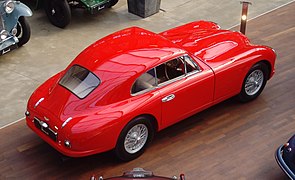Aston Martin DB2
| Aston Martin DB2 | |
|---|---|
FR layout | |
| Related | Aston Martin DB3 |
| Powertrain | |
| Engine | 2.6 L Lagonda I6 |
| Dimensions | |
| Wheelbase | 99 in (2,500 mm)[2] |
| Length | 162.5 in (4,130 mm)[2] |
| Width | 65 in (1,700 mm)[2] |
| Height | 53.5 in (1,360 mm)[2] |
| Chronology | |
| Predecessor | 2-Litre Sports "DB1" |
| Successor | Aston Martin DB2/4 |
The Aston Martin DB2 is a
Development and racing
In 1947
In its original form the Lagonda straight-6 had a 78 mm (3.07 in) bore and 90 mm (3.543 in) stroke, and produced about 105 hp (78 kW) with dual SU carburettors. The DB2 utilized it in a shortened version of the tube-frame chassis designed by Claude Hill for the Aston Martin 2-Litre Sports, with a fastback coupé body designed by Frank Feeley.
Three pre-production cars were entered for the 1949 24 Hours of Le Mans. One, which would become the development car for the production DB2, had the Lagonda straight-6, while the four-cylinder Aston Martin 2-litre unit powered the other two. After six laps the Lagonda-powered car, driven by Leslie Johnson, retired with overheating caused by failure of the water pump. One of the 2-litre cars was in 4th place and running without brakes when it crashed two hours short of the finish, fatally injuring driver Pierre Maréchal. The other finished 7th, crewed by Arthur Jones and Nick Haines. A month later, the larger-engined car, driven by Leslie Johnson and Charles Brackenbury, finished 3rd in the Spa 24-hour race, where one of the 2-litre cars was driven to 5th by Nick Haines and Lance Macklin.
For 1950 all three factory team cars were equipped with the Lagonda engine. At the
David Brown soon embarked on a series of Aston Martins designed specifically for competition use, starting with the DB3.
Production
The DB2 debuted at the
The single-piece bonnet was hinged at the front. At the rear of the fixed-head coupé (FHC) a small top-hinged lid gave access to the spare wheel, and luggage space was behind the front seats, accessible only from inside the car.
Later in 1950, a Drophead Coupé (DHC) variant was introduced. At least 102 were built.[3]
In April 1950, an engine with larger
Performance
A closed coupé tested by the British magazine
-
The fourth and last DB2 prototype, built in 1949 for David Brown's personal use
-
Aston Martin DB2 straight-6 engine
-
The Aston Martin DB2 closed coupé body was a fastback design by Frank Feeley
-
1951 Aston Martin DB2 Drophead Coupé
-
1953 Aston Martin DB2 competition quasi-Vantage
References
- ISBN 1-870979-39-7.
- ^ The Motor. 27 September 1950.
- ^ Serio, Steve (August 2010). "1950 Aston Martin DB2 Vantage Coupé". Sports Car Market. 22 (8): 58–59.
- ^ "Aston Martin DB2 Sports Saloon (road test)". Autocar. 21 April 1950.
With the 6.5 to 1 ratio in the car tested not the slightest sign of pinking or running-on was experienced on 72 octane Pool fuel under any circumstances; with the 8.2 ratio a higher octane fuel would be necessary or highly desirable.
Further reading
- "Aston Martin DB2". AstonMartins.com. Retrieved 23 June 2005.
- AMOC register for production dates and information on Willie Watson
External links
- Aston Martin Scrapbook on Washboards Astonunts.free.fr





